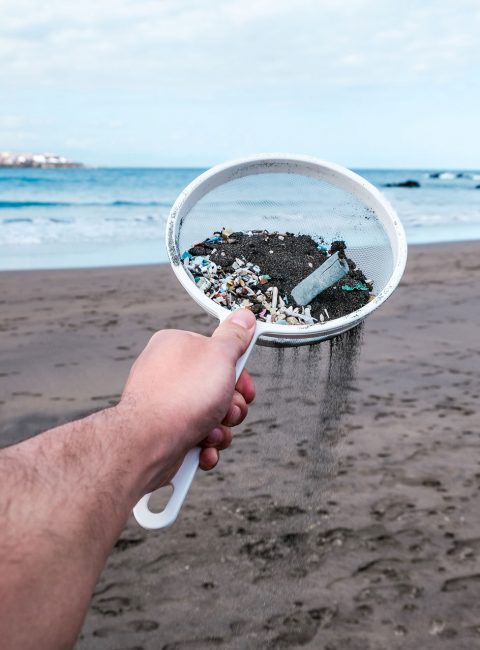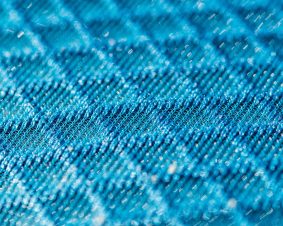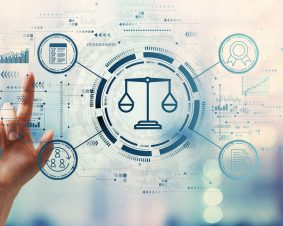 >
Spotlight August 2022: Three-stage model for the formation of micro- and nanoplastic particles.
>
Spotlight August 2022: Three-stage model for the formation of micro- and nanoplastic particles.
Plastic pollution is a global problem that will continue to affect humanity for more than 100 years. There is the visible pollution, e.g. plastic debris in the environment, which leads to death for many animals (because they mistakenly think the plastic is food and eat it or because they get caught in the plastic waste). However, one process that occurs not visible to the naked eye is the decay of large pieces of plastic into smaller fragments (microplastics), which in turn decompose into even smaller particles, called Nanoplastic (more information about nanoplastic in the environment).
How exactly the process of decomposition due to weathering occurs and what exactly happens to nanoplastic particles was investigated in the paper presented here. The starting point for the investigation were plastic pellets in the medium size range of 100- 200 µm, which were exposed to laboratory weathering by water and solar radiation. In this manner, natural weathering by rain and solar radiation in Central Europe was imitated over a period of 1.5 years. The degradation could be divided into 3 main stages. First, the large fragments were smoothed by surface abrasion over a period of up to 17 days and smaller fragments detached (stage 1). After a period of at least 58 days, cracks formed on the plastic surface (stage 2). Finally, the cracks lead to the detachment of smaller particles (stage 3). Up to 14,000 nano- and microplastic particles could form from one original particle. The nanoplastic particles subsequently form larger agglomerates with microplastic particles. This could explain why individual nanoplastic particles are so difficult to detect in the environment. Environmental organisms will thus be exposed to nanoplastic and microplastic particles simultaneously. At the same time, nanoplastic particles bound to natural particles may also enter the food chain.
The experiments on the laboratory weathering of larger pieces of plastic into nano- and microplastic particles provide important insights into the environmental behavior of plastic. They also showed that there are different decomposition processes for different polymers.
Original Publication:
Menzel T., Meides N., Mauel A., et al. Degradation of low-density polyethylene to nanoplastic particles by accelerated weathering,
Science of The Total Environment 2022; 826 (154035). https://doi.org/10.1016/j.scitotenv.2022.154035

Weitere Spotlights
Spotlight February 2023: New sustainable and promising method to give cotton textiles an antiviral and antibacterial finish
Textiles have been the subject of research into functionalization for many years, especially also to repel bacteria and viruses. Since the development of nanotechnological processes, there have been many attempts to incorporate UV protection with nano-titanium dioxide, or to provide textiles with anti-bacterial properties with nanosilver (see cross-sectional text “Nanoparticles in Textiles”). But nanosilver has […]
Read moreSpotlight July 2022: New definition on nanomaterials published
The European Union has published a new definition for nanomaterials as of June 2022. It is recommended that this be used as a basis for future legislation. The new documents can be found on the EC website. In the new “nanodefinition”, the essential components such as the origin or the size range of the particles […]
Read moreSpotlight November 2023: Early Awareness and Action System for Advanced Materials (Early4AdMa)
Advanced materials hold immense potential to address global challenges such as environmental degradation, transformation of the energy sector, and development towards circularity. To harness their benefits while ensuring safety and sustainability, regulatory bodies, scientific communities, and industries have recognized the need for proactive approaches. The “Early4AdMa” system is a pre-regulatory risk governance tool for advanced […]
Read moreSpotlight February 2022: Probabilistic risk assessment – the keystone for the future of toxicology
The basics of toxicology are constantly being reconsidered, and the approach to risk assessment is therefore constantly being put to the test, because, as William Osler is cited in this publication, “Medicine (toxicology) is a science of uncertainty and an art of probability“. In this recent paper, the team around Thomas Hartung (Johns-Hopkins University/University of […]
Read more


